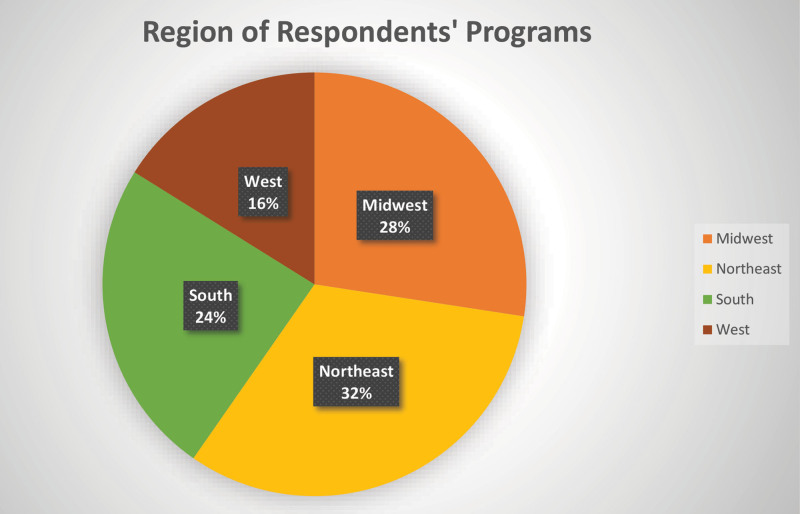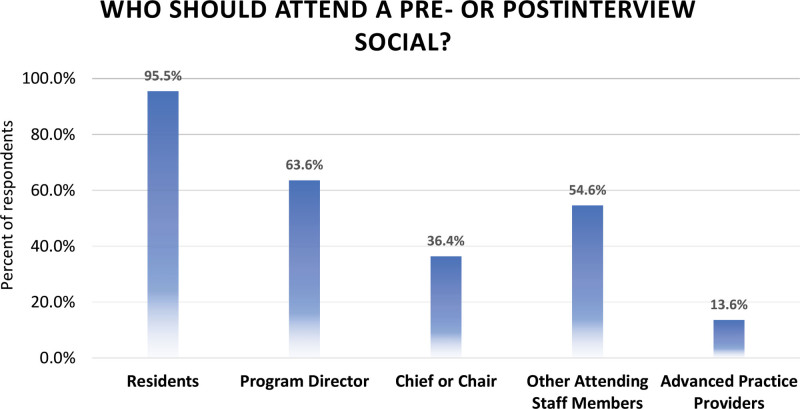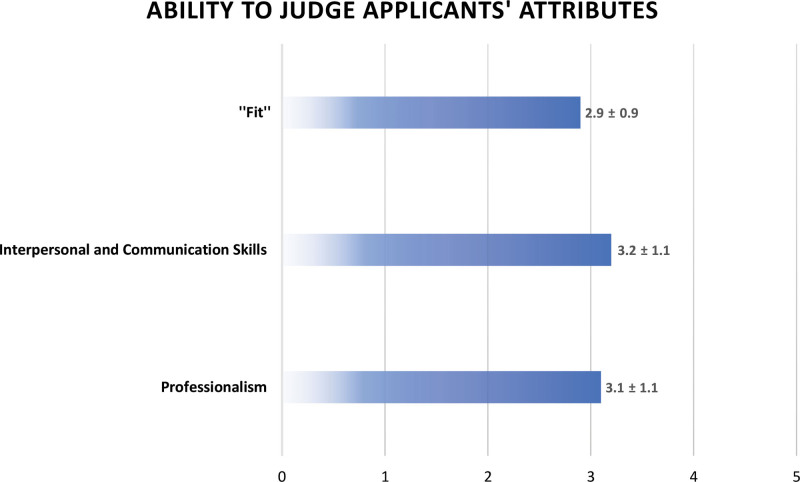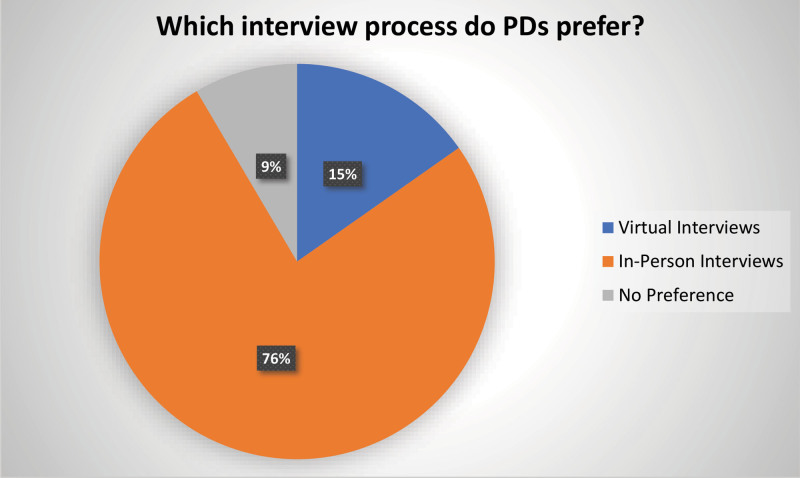Background:
Interviews for the integrated plastic surgery residency match took place in a virtual format for the 2020–2021 application cycle. Current literature lacks the perspectives of program directors (PDs) on virtual interviews compared with traditional in-person interviews.
Methods:
Following institutional review board approval, an anonymous 17-question survey was distributed by email to 82 program directors of integrated plastic surgery residency programs in the United States. Participants were asked baseline program information, the number of positions and interview invites offered, and their perspectives on various aspects of the virtual interview process.
Results:
Sixty-two (75.6%) PDs completed the survey. Thirty-seven percent reported increasing the number of interview offers per available residency spot. On a five-point Likert scale (1, not well at all; 5, extremely well), PDs showed no significant differences in their ability judge an applicant’s professionalism (3.1 ± 1.1), interpersonal and communication skills (3.2 ± 1.1), and “fit” with their program (2.9 ± 0.9) during virtual interviews (P = 0.360). Sixty-eight percent reported being satisfied (15.3% extremely satisfied, 52.5% somewhat satisfied) with the virtual interview process, though 76.3% preferred in-person interviews.
Conclusions:
This study is the first to provide insight into PDs’ impressions of virtual residency interviews. Although most reported being satisfied with the virtual interview process, the majority still preferred in-person interviews. Further long-term studies evaluating the pros and cons of each interview modality may provide more information on whether virtual interviews could become a sustainable alternative to the traditional in-person residency interview.
Takeaways
Question:
What are the perspectives of program directors on the 2020-21 virtual interview application cycle for the integrated plastic surgery residency match?
Findings:
A survey of integrated plastic surgery program directors was performed. Sixty-eight percent of program directors reported being satisfied with the virtual interview process, however, 76.3% preferred inperson interviews.
Meaning:
Most program directors preferred in-person compared to virtual interviews, though long-term data analyzing outcomes of the match during the virtual interview cycle compared to in-person is necessary to delineate whether it is an acceptable and equitable modality.
INTRODUCTION
The categorical integrated plastic surgery residency match is one of the most competitive specialties within the National Resident Matching Program. Applicants routinely have high USMLE Step 1 and Step 2 CK scores, numerous research experiences and publications, and membership in the Alpha Omega Alpha honor society.1 A prior study evaluating the residency application process from the perspective of program directors (PDs) identified performance on away/subinternship rotations and interviews as the two most important factors in selecting residents.2 To increase their chances of matching, many integrated applicants participate in multiple away rotations to both make a good impression and determine whether the program is a “good fit.”3 Following the conversion to a pass/fail system on USMLE Step 1, a survey of integrated plastic surgery PDs showed that applicant familiarity was the most important factor for selecting an applicant to interview.4 In the months leading up to the 2020–2021 residency application cycle, however, many institutions suspended sub-internship rotations because of the COVID-19 pandemic, hindering both applicants’ and PDs’ abilities to establish familiarity and determine “fit.”5
Interviews took place via a virtual format in the 2020–2021 application cycle as a result of the Coronavirus Disease 2019 (COVID-19) pandemic, which further changed the integrated plastic surgery residency landscape.6,7 Virtual or web-based interviews are not new to the 2020–2021 residency application cycle and have been studied previously, but definitive data on whether the virtual interview process is a suitable and equitable substitute for in-person interviews is lacking.8–10 Prior studies have examined the advantages and disadvantages of each format as they relate to the plastic surgery residency process, but whether one or the other is superior remains undetermined.11
Due to the widespread unfamiliarity of virtual interviews in the residency application process, current perspectives on this process, as it compares to in-person interviews in plastic surgery, are unknown. We sought to assess the perspectives of integrated plastic surgery PDs following the 2020–2021 application cycle to better characterize the potential role of this interview modality in future application cycles.
METHODS
Following institutional review board approval by The Ohio State University (IRB #2021E0262), an electronic survey consisting of a maximum of seventeen questions with branching logic was distributed through SurveyMonkey (surveymonkey.com, Palo Alto, Calif.) to PDs of integrated plastic surgery residency programs. Eighty-two potential participants were identified as the PDs of programs who were established before the October 21st, 2020 Electronic Residency Application Services (ERAS) opened for application submission. An initial recruitment email was sent on March 12, 2021 with reminder emails sent on days 7 and 15, and the survey was closed on day 24.
Each participant was asked to provide the geographic region in which their program was located, the number of available residency positions offered for the incoming 2021 resident class, the number of applicants they interviewed, and whether the number of interviewed applicants was greater than in previous years. Participants were then asked to provide details on whether they hosted a preinterview social, followed by various questions regarding its utility. Next, the participants were asked to rate how well they were able to judge an applicant’s professionalism, interpersonal and communication skills, and “fit” with their program on a Likert scale, ranging from 1 (not well at all) to 5 (extremely well). Preference for a virtual or in-person interview process and any additional thoughts on the topic were also queried. Two additional questions regarding each PD’s current thoughts and opinions on their respective first-year residents who interviewed during the in-person 2019–2020 interview cycle were included for use in a long-term study, and are not discussed in this article. (See survey, Supplemental Digital Content 1, which displays the initial 15 questions that are discussed. http://links.lww.com/PRSGO/B733.)
Responses to the ability to judge an applicant’s various attributes were analyzed using a one-way ANOVA test with posthoc Tukey to determine differences between groups. A P-value of more than 0.05 was considered significant. Analysis was performed using IBM SPSS Statistics for Macintosh (IBM Corp., version 27.0, Armonk, N.Y.).
RESULTS
Baseline Data and Available Spots
Sixty-two of 82 program directors responded to the survey (75.6%). The majority of PDs (32.3%) were from the Northeast, with the remaining 27.4%, 24.2%, and 16.1% from the Midwest, South, and West, respectively (Fig. 1). The mean number of available residency positions and number of interview invitations each program offered were 2.4 and 41.4, respectively. Overall, each program offered a mean 20.5 interview invitations per available position. Twenty-three (37.1%) PDs reported increasing the number of interview slots per available residency position. Of those who did increase the number of slots, of which the average increase was 6.5 slots per available position. Taking into account programs that did not increase the number of interview slots, this translated into an overall specialty-wide increase of 4.0 interview slots per available position.
Fig. 1.
Location of each program.
Pre- or Postinterview Socials
Twenty-two PDs shared their perspectives on pre- or postinterview virtual socials. Most (45.5%) PDs reported an ideal time for a social of 1–2 hours, followed by 40.9% reporting 30–59 minutes, and 4.6% reporting over 2 hours. When asked who should attend a social, 95.5% of PDs agreed that residents should be present. Additional members who should attend the social are shown in Figure 2. Overall, 36.4% of PDs found the social either “very useful” or “extremely useful,” 22.7% found it “somewhat useful,” and 13.6% found it “not so or not at all useful.”
Fig. 2.
Who should attend a pre- or postinterview social?
Interview Specifics
PDs were asked how well they were able to judge professionalism (average Likert scale weight ± SD, 3.1 ± 1.1), interpersonal and communication skills (3.2 ± 1.1), and “fit” with their program (2.9 ± 0.9), as shown in Figure 3. There were no significant differences between the ability of PDs to assess these different domains (P = 0.360). When asked about their satisfaction with the virtual interview process, 67.8% reported being satisfied (15.3% extremely satisfied, 52.5% somewhat satisfied). Fifteen percent were neither satisfied nor dissatisfied, and the remaining PDs were either somewhat dissatisfied (13.6%) or extremely dissatisfied (3.4%). Finally, when asked which interview process PDs preferred, 76.3% preferred in-person interviews, as shown in Figure 4.
Fig. 3.
Ability to judge an applicant’s various attributes. Data are presented as mean ± SD.
Fig. 4.
Which interview process do PDs prefer?
DISCUSSION
The Coalition for Physician Accountability12 and American Council of Academic Plastic Surgeons6 recommended all interviews take place in a virtual format for the 2020–2021 residency application cycle to help combat the spread of COVID-19. While virtual residency/fellowship interviews are not an entirely new entitiy,8–10 the short- and long-term implications of a completely virtual interview cycle are not well understood. While the majority of the current literature examines the virtual interview process as it relates to applicants,8,9,13 this study is the first to assess the perspectives of categorical integrated plastic surgery residency PDs. With a 75.6% response rate, this study also reflects a collective majority opinion of the process.
Our results demonstrate that the majority of PDs (76.3%) preferred in-person interviews over virtual interviews, despite 67.8% being either somewhat or extremely satisfied with the virtual interview process. These data coincide with a survey of female pelvic medicine and reconstructive surgery PDs, reported by Menhaji et al,14 which showed that only 31% of respondents preferred a virtual interview, but 86.7% were satisfied with them. Similarly, all participants in a survey by Chandler et al either disagreed or strongly disagreed that videoconferencing interviews could substitute for an in-person interview when evaluating candidates for the pediatric surgery fellowship match, although only three faculty reported in the virtual interviews.8
Surveys from other subspecialties, however, show conflicting data. A survey of complex general surgical oncology fellowship program directors reported that 63% of PDs agreed or strongly agreed that they were comfortable creating a rank list after virtual interviews.15 Furthermore, 60% of PDs reported they would choose to continue virtual interviews over in-person interviews. This is in agreement with results reported by Menhaji et al,14 which showed that although PDs did not prefer virtual interviews, 60% reported that they would likely continue them.
The transition to widespread virtual interviews corresponded with a large increase in the total number of integrated plastic surgery applicants.16 The total number of applicants to categorical integrated plastic surgery residency programs increased by 58 from the previous year, to a total of 416 applicants; programs received an average of 298 applications, which is an increase of 45 from the previous year, representing an 18% increase. With the number of applicants trending upward, 37% of programs increased the number of interview slots per available position by an average of 6.5.
The concept of “interview hoarding” has been described in plastic surgery,17 and was further discussed for all residencies in an open letter from the Association of American Medical Colleges.18 These reports urged applicants to accept no more than 15 interview invitations or any more than needed, respectively. In an open-response text box at the end of our survey, PDs had the option to add any additional information they wished to share. Three PDs suggested a cap on the number of interviews each applicant can accept to help combat “interview hoarding.” Supporting this point, an analysis of the independent plastic surgery match suggests that many competitive applicants attended more interviews than needed.19 However, no integrated plastic surgery program went unfilled in the 2021 match.20 Further investigation is required, given the uncertainty of the effects of potential “interview hoarding” on match results from the applicant and PD standpoint.
Limitations
This survey is limited by the potential for response and nonresponse bias. Though 75.6% of program directors responded, the anonymity of the survey responses and limited demographic information eliminated the opportunity to perform a nonresponder analysis. Additionally, the survey was deployed after the completion of the 2020–2021 application cycle. As a result, the amount of time each program director had between their respective interview day(s) and completing the survey varied and was not quantified. The survey referenced only integrated interviews and not independent interviews, which limits generalizability.
CONCLUSIONS
Sixty-two (75.6%) of 82 integrated plastic surgery program directors completed a survey on their perspectives of the virtual interview experience during the 2020–2021 application cycle. Sixty-eight percent of PDs were satisfied with the virtual interview process; however, 76.3% preferred in-person interviews. Long-term data and perspectives examining how programs and residents who interviewed during the virtual 2020–2021 application cycle compare with other in-person cycles will help unveil whether virtual interviews are a suitable replacement for in-person interviews.
Supplementary Material
Footnotes
Published online 27 July 2021.
Disclosure: Dr. Janis receives royalties from Thieme and Spring Publishing. Dr. Lin receives royalties from McGraw-Hill. All the other authors have no financial interest to declare in relation to the content of this article. No funding was received for this article.
Related Digital Media are available in the full-text version of the article on www.PRSGlobalOpen.com.
REFERENCES
- 1.National Resident Matching Program. Charting outcomes in the match: senior students of U.S. MD medical schools. 2020. Available at https://mk0nrmp3oyqui6wqfm.kinstacdn.com/wp-content/uploads/2020/07/Charting-Outcomes-in-the-Match-2020_MD-Senior_final.pdf. Accessed March 17, 2021.
- 2.Janis JE, Hatef DA. Resident selection protocols in plastic surgery: a national survey of plastic surgery program directors. Plast Reconstr Surg. 2008;122:1929–1939. [DOI] [PubMed] [Google Scholar]
- 3.Drolet BC, Brower JP, Lifchez SD, et al. Away rotations and matching in integrated plastic surgery residency: applicant and program director perspectives. Plast Reconstr Surg. 2016;137:1337–1343. [DOI] [PubMed] [Google Scholar]
- 4.Asaad M, Drolet BC, Janis JE, et al. Applicant familiarity becomes most important evaluation factor in USMLE step I conversion to pass/fail: a survey of plastic surgery program directors. J Surg Educ. 2021;S1931-7204(21)00007-6 [E-pub ahead of print]. [DOI] [PubMed] [Google Scholar]
- 5.Haley C, Lee J, Xun H, et al. The negative impact of COVID-19 on medical education amongst medical students interested in plastic surgery: a cross-sectional survey study. Plast Reconstr Surg Glob Open. 2021;9:e3535. [DOI] [PMC free article] [PubMed] [Google Scholar]
- 6.American Council of Academic Plastic Surgeons. Important COVID-19 related announcements. vol 2020. 2020. Available at https://acaplasticsurgeons.org/covid.cgi. Accessed January 31, 2020.
- 7.Sarac BA, Calamari K, Janis J. Virtual residency interviews: optimization for applicants. Cureus. 2020;12:e11170. [DOI] [PMC free article] [PubMed] [Google Scholar]
- 8.Chandler NM, Litz CN, Chang HL, et al. Efficacy of videoconference interviews in the pediatric surgery match. J Surg Educ. 2019;76:420–426. [DOI] [PubMed] [Google Scholar]
- 9.Vadi MG, Malkin MR, Lenart J, et al. Comparison of web-based and face-to-face interviews for application to an anesthesiology training program: a pilot study. Int J Med Educ. 2016;7:102–108. [DOI] [PMC free article] [PubMed] [Google Scholar]
- 10.Jones RE, Abdelfattah KR. Virtual interviews in the era of COVID-19: a primer for applicants. J Surg Educ. 2020;77:733–734. [DOI] [PMC free article] [PubMed] [Google Scholar]
- 11.Teven CM, Casey WJ, Rebecca AM. Medical residency interviews: time for a change? Plast Reconstr Surg Glob Open. 2020;8:e3037. [DOI] [PMC free article] [PubMed] [Google Scholar]
- 12.The Coalition for Physician Accountability’s Work Group on Medical Students in the Class of 2021 Moving Across Institutions for Post Graduate Training. Final report and recommendations for medical education institutions of LCME-accredited, U.S. osteopathic, and non-U.S. medical school applicants. 2020. Available at https://www.aamc.org/system/files/2020-05/covid19_Final_Recommendations_05112020.pdf. Accessed March 17, 2021.
- 13.Bamba R, Bhagat N, Tran PC, et al. Virtual interviews for the independent plastic surgery match: a modern convenience or a modern misrepresentation? J Surg Educ. 2021;78:612–621. [DOI] [PMC free article] [PubMed] [Google Scholar]
- 14.Menhaji K, Gaigbe-Togbe BH, Hardart A, et al. Virtual interviews during COVID-19: perspectives of female pelvic medicine and reconstructive surgery program directors. Female Pelvic Med Reconstr Surg. 2020[E-pub ahead of print]. [DOI] [PMC free article] [PubMed] [Google Scholar]
- 15.Hill MV, Ross EA, Crawford D, et al. Program and candidate experience with virtual interviews for the 2020 Complex General Surgical Oncology interview season during the COVID pandemic. Am J Surg. 2021;222(1):99–103. [DOI] [PubMed] [Google Scholar]
- 16.Association of American Medical Colleges. ERAS Statistics. Available at https://www.aamc.org/data-reports/interactive-data/eras-statistics-data. Accessed March 17, 2021.
- 17.Boyd CJ, Ananthasekar S, Vernon R, et al. Interview hoarding: disparities in the integrated plastic surgery application cycle in the COVID-19 pandemic. Ann Plast Surg. 2021;87:1–2. [DOI] [PMC free article] [PubMed] [Google Scholar]
- 18.Whelan A. Open Letter on Residency Interviews. 2020. Available at https://www.aamc.org/media/50291/download. Accessed March 17, 2021.
- 19.Malafa MM, Nagarkar PA, Janis JE. Insights from the San Francisco Match rank list data: how many interviews does it take to match? Ann Plast Surg. 2014;72:584–588. [DOI] [PubMed] [Google Scholar]
- 20.National Resident Matching Program. Advance data table 2021 main residency match. 2021. Available at https://mk0nrmp3oyqui6wqfm.kinstacdn.com/wp-content/uploads/2021/03/Advance-Data-Tables-2021_Final.pdf. Accessed April 06, 2021.
Associated Data
This section collects any data citations, data availability statements, or supplementary materials included in this article.






